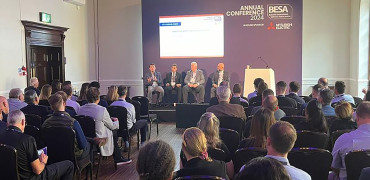I don’t think there has been a single incident which has had such wide-reaching implications for the construction industry as the Grenfell Tower fire.
The ensuing government enquiry and proposals for change in the industry will have repercussions for everyone involved in the design, delivery and operation of buildings.
At the 2024 BESA Conference in October, the keynote speaker was Peter Apps, a journalist and author who has followed the story of the fire and the resulting enquiry in detail. His speech was both moving and insightful. It included his view of the impact on the individuals involved in the construction and refurbishment of that building - and how it would affect their lives forever.
It was a sobering moment for delegates, and it brought home the core message of the Building Safety Act. Responsibility for building safety lies with everyone in the construction team. It cannot be passed down the line to ‘someone else’.
At the end of the day only the industry can ensure that we never see another Grenfell
A wider definition of height
As everyone should now be aware, the Act applies to all building works that are subject to Building Regulations. There are additional requirements for ‘high risk’ buildings. Currently, that means residential buildings over a certain height. However, Sir Martin Moore-Blick’s final report into Grenfell recommends that this ‘arbitrary’ height definition should be widened.
Competence that is backed by certification/accreditation is the foremost issue for contractors right now. The government-appointed Safety Regulator can enforce competence requirements on individuals undertaking building work. Organisations must also have evidence that they can fulfil the work they are undertaking. This also applies to their supply chain.
From a technical perspective, the HVAC industry is very familiar with the need for continuous training. In the past few years, we have seen the introduction of new technologies and materials such as low-GWP refrigerants and the wider application of heat pump technology. So, in many ways the element of ‘competence’ to do the job at hand should not be too difficult for reputable operators in the sector to achieve.
Raising issues on site
But doing the job well will not be enough, and certainly not in the spirit of the Act. Sir Martin Moore-Blick highlighted that the Grenfell Tower victims were failed by: “incompetence, but in some cases dishonesty and greed’. While it’s straightforward enough to weed out incompetence with tough regulation, building trust and responsibility are on a different level.
Speaking at the Conference, BESA’s Chief Executive David Frise asked delegates: “If you are on site and see something that is not installed correctly or safely, will you raise the issue?”
This is where a changing culture is needed in the construction industry. To see that someone has drilled a hole in the wrong place and shake your head in despair at the poor workmanship is one thing. To report it to a manager or the ‘responsible person’ as a potential safety hazard is quite another. Would that individual be labelled a ‘troublemaker’? Will their company find itself edged out of future projects?
A few Conference delegates pointed out that one of the primary issues at Grenfell Tower was that a number of companies involved in its refurbishment were not experienced in delivering that type of project. And many agreed that contractors should turn away work where they did not have confidence in their ability to achieve safe outcomes. Again, this is an issue of business culture – are contractors ready to say no to work in a competitive market?
Confidence to speak out
Giving site operatives the confidence to speak out on safety issues means ensuring the culture of your business (no matter what its size) is focused on delivering both the requirements and the spirit of the Building Safety Act. Employees must know that company management will support them if they say something. In an industry which focuses on getting the job done quickly and to tight margins, this is the biggest challenge of the new regulation.
The list of recommendations for the industry from the final Grenfell enquiry output is detailed and extensive (see BESA’s summary here). But it does not directly address this issue of ‘culture’. Yet without that, it is possible as an HVAC contractor to follow the recommendations and to acquire the certificates of competence and still fail to deliver what the Act is trying to accomplish.
Amid discussions about competence, product testing, Gateways and accreditation, the most challenging and fundamental requirement of the Building Safety Act is a change in our industry’s culture. The Act can achieve safer buildings through legal requirements. But only the industry can ensure that we never see another Grenfell.
Karen Fletcher, editor The SectorScope




